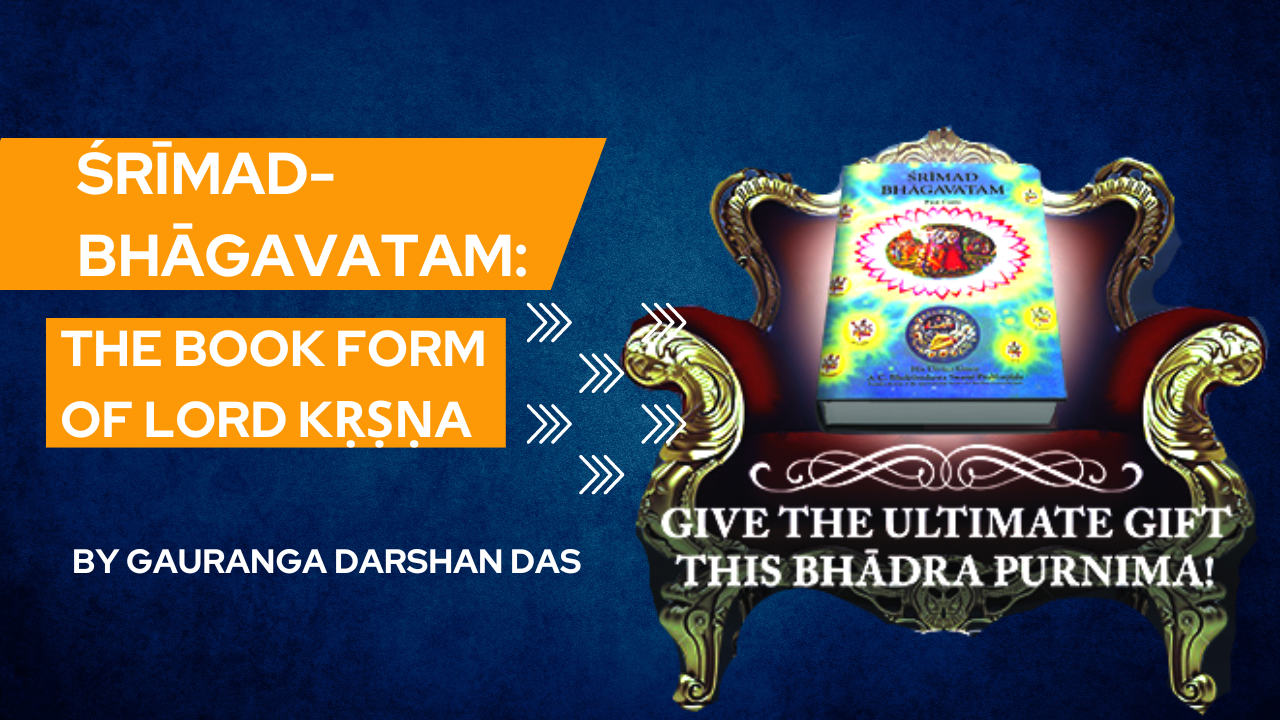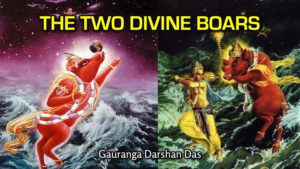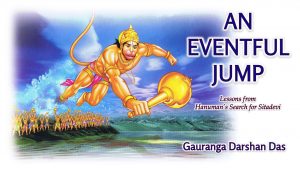Srimad Bhagavatam: The Book Form of Lord Krishna
by Gauranga Darshan Das
A brief outline of the twelve cantos of the Bhagavatam, which represent the bodily limbs of Lord Krishna and present ten transcendental topics.
Of all the sacred Vaiṣṇava scriptures, Śrīmad-Bhāgavatam is considered the topmost. Lord Śrī Caitanya Mahāprabhu hailed the Bhāgavatam as the spotless authority (pramāṇam amalam) amongst the Vedic literatures. Śrīla Rūpa Gosvāmī, in his Bhakti-rasāmṛta-sindhu, declared that hearing Śrīmad-Bhāgavatam is one of the five most potent forms of bhakti-yoga. Śrīla Prabhupāda regarded Śrīmad-Bhāgavatam, which is the sound representation of Lord Kṛṣṇa, as the postgraduate study of the science of Godhead.
Śrīmad-Bhāgavatam was compiled by Śrīla Vyāsadeva, the literary incarnation of Godhead, in the maturity of his knowledge. The Bhāgavatam gave complete satisfaction to its author, who was not satisfied with his earlier works, including various other Purāṇas and the Mahābhārata. All the Vedic scriptures together are compared to a desire-fulfilling tree, and Śrīmad-Bhāgavatam is the ripened fruit of that tree, the essence of all scriptures (akhila-śruti-sāram).
The Bhāgavatam’s Cantos Are Kṛṣṇa’s Limbs
Śrīmad-Bhāgavatam is nondifferent from the Supreme Personality of Godhead Lord Kṛṣṇa. It is the granthāvatāra, or book incarnation of Lord Kṛṣṇa, narrating the pastimes of His various avatars. After His time on earth, Kṛṣṇa returned in the form of this book to shed light on the misdirected civilization of Kali-yuga.
Śrīmad-Bhāgavatam’s twelve cantos represent the limbs of Lord Śrī Kṛṣṇa’s transcendental body, according to the following verses of the Padma Purāṇa.
pādau yadīyau prathama-dvitīyau
tṛtīya-tūryau kathitau yad-ūrū
nābhis tathā pañcama eva ṣaṣtho
bhujāntaraṁ dor-yugalaṁ tathānyau
kaṇṭhas tu rājan navamo yadīyo
mukhāravindaṁ daśamaḥ praphullam
ekādaśo yasya lalāṭa-paṭṭaṁ
śiro’pi tu dvādaśa eva bhāti
tam ādidevaṁ karuṇā-nidhānaṁ
tamāla-varṇaṁ suhitāvatāram
apāra-saṁsāra-samudra-setuṁ
bhajāmahe bhāgavata-svarūpam
“The First and Second Cantos of the Bhāgavatam are Śrī Kṛṣṇa’s lotus feet. The Third and Fourth Cantos are His thighs. The Fifth Canto is His navel. The Sixth Canto is His chest. The Seventh and Eighth Cantos are His arms. The Ninth Canto is His throat. The Tenth Canto is His beautiful lotus face. The Eleventh Canto is His forehead. The Twelfth Canto is His head. I bow down to that Lord, the ocean of mercy whose color is like that of a tamāla tree and who appears in this world for the welfare of all. I worship Him as the bridge for crossing the unfathomable ocean of material existence. The Bhāgavatam has appeared as His very Self.”
To view the deity of Kṛṣṇa in the temple, we are advised to begin at His lotus feet and gradually rise to His lotus face. Similarly, because the Bhāgavatam is nondifferent from Lord Kṛṣṇa, one should study it step by step from the first canto to the last. Śrīla Prabhupāda emphasizes, “The only qualification one needs to study this great book of transcendental knowledge is to proceed step by step cautiously and not jump forward haphazardly as with an ordinary book. It should be gone through chapter by chapter, one after another.” (Preface to Śrīmad-Bhāgavatam)
The Ten Topics of Śrīmad-Bhāgavatam
Glorified as a mahā-purāṇa, or “great Purāna,” Śrīmad-Bhāgavatam contains ten subjects, as described in this verse 2.10.1:
atra sargo visargaś ca
sthānaṁ poṣaṇam ūtayaḥ
manvantareśānukathā
nirodho muktir āśrayaḥ
- Sarga: universal creation by the Supreme Lord
- Visarga: secondary creation by Lord Brahmā
- Sthānam: positioning of living entities in various planetary systems
- Poṣaṇam: protection of the devotees by the Lord
- Ūti: inclination to act
- Manvantara: the reign of Manus
- Īśānukatha: the topics of the Lord’s incarnations and devotees
- Nirodha: annihilation
- Mukti: liberation
- Āśraya: the supreme shelter, Lord Kṛṣṇa.
All aspects of knowledge important for human beings, summarized in the above ten categories, are described with various degrees of emphasis and analysis throughout the Śrīmad-Bhāgavatam. Although all these topics are spread throughout the Bhāgavatam, each is more vividly described in specific cantos.
The ultimate purpose of the first nine topics is to help us understand the tenth topic, āśraya-tattva. The first nine topics deal with the Supreme Lord Kṛṣṇa’s various energies, expansions, majesty, and greatness. Understanding them helps us better appreciate His personal attributes and His activities with His dearest devotees as described in the Tenth Canto. Without studying the first nine topics, one might perceive the pastimes of Kṛṣṇa in the Tenth Canto as ordinary.
Śrīmad-Bhāgavatam in a Nutshell
The First and Second Cantos of the Bhāgavatam are considered the lotus feet of Lord Kṛṣṇa. They form a perfect prelude to the rest of the Bhāgavatam by introducing the reader to its key philosophical concepts and prominent characters. They also emphatically, categorically, and conclusively declare Lord Kṛṣṇa as the Supreme Personality of Godhead (kṛṣṇas tu bhagavān svayam) and bhakti-yoga as the topmost spiritual path. In the First Canto, Sūta Gosvāmī describes to the Naimisharaṇya sages the history of the Bhāgavatam; the birth and activities of Parīkṣit Mahārāja, who even chastised Kali, the personification of the current degraded age; and the exclusive dependence on Lord Kṛṣṇa by devotees like Uttarā, the Pāṇḍavas, Kunti, and Bhīṣma and Kṛṣṇa’s reciprocation with them.
In the Second Canto, Śukadeva Gosvāmī describes the supremacy of kṛṣṇa-bhakti while presenting various other processes on the Vedic landscape, such as demigod worship and, as a part of aṣṭānga yoga, meditation on the universal form (virāṭ-rūpa) and the Supersoul (Paramātmā). He also explains the catuḥ-ślokī (the four seed verses of the Bhāgavatam) and finally defines the ten topics of the Bhāgavatam.
The Third and Fourth Cantos correspond to Lord Kṛṣṇa’s thighs and predominantly describe the topics of sarga and visarga through the conversation of Vidura and Maitreya. The Third Canto also describes time, embryology, family life, Sāṅkhya, bhakti-yoga, aṣṭāṅga-yoga, jñāna-yoga, karma, and the spiritual and material worlds. We read the pastimes of Lord Varāha, a description of Vaikuṇṭha, the narration of the household life of Kardama Muni and Devahūti, and the teachings of Lord Kapila.
The Fourth Canto is very rich in its contents. It unveils inspiring and instructive stories of admired personalities like Lord Śiva, Sunīti, Dhruva, Nārada, Aṅga, Pṛthu, and the Pracetās, who all showed extraordinary examples of bhakti. We also learn about unfavorable attitudes in bhakti from the mistakes of characters like Dakṣa, Suruci, Vena, Indra, and Prācīnabarhi. We get to witness how the positive transformation undergone by many of these personalities, mainly due the intervention of devotees, adds to the glory of bhakti. Furthermore, the prayers of pure devotees like Dhruva, Pṛthu, and the Pracetās uncover the highest aspiration of a devotee – to hear kṛṣṇa-kathā in the association of devotees.
The Fifth Canto corresponds to the lotus navel of the Supreme Lord. In this canto, Śukadeva Gosvāmī continues the topic of visarga and describes the dynasty of Priyavrata, the second son of Manu. Priyavrata’s dynasty consists of several notable personalities, such as Āgnīdhra, Nābhi, Lord Ṛṣabhadeva, and Bharata in his three lives as a king, a deer, and a brāhmaṇa. All these episodes culminate in the glorification of bhakti. The latter half of this canto discusses sthānam, the positioning of various planetary systems within the structure of the universe for the inhabitation of various living entities. The canto concludes with a description of hellish planets. The majesty and grandeur of the Lord’s creation is unfathomable for an ordinary human being. It is recommended that one faithfully adhere to the teachings of the scriptures and pursue the spiritual path.
The Sixth Canto represents the chest of Lord Kṛṣṇa. It is primarily centred on the theme of poṣaṇam, or protection offered by the Lord to His devotees, even if they sometimes transgress the laws of dharma accidentally. This canto begins with glorification of the Lord’s holy names through the episode of Ajāmila. Later Śukadeva Gosvāmī resumes the topic of visarga and describes the living entities generated through the sixty daughters of Dakṣa. As a part of those descriptions, Indra’s offenses and struggles are described along with the glories of the pure devotee Vṛtrāsura. Vṛtrāsura’s previous life as King Citraketu reveals the insubstantial nature of material relationships, the compassion of a devotee in uplifting a struggling soul, the care needed in dealing with devotees, and the Supreme Lord’s eagerness to reclaim His devotees. The canto concludes with the transformation of Diti and Indra by devotional service.
The Seventh and Eighth Cantos represent the arms of the Supreme Lord. The Seventh Canto describes ūti, or inclination, which is of two types – auspicious and inauspicious. The auspicious and inauspicious inclinations of the jīvas lead them to perform pious and impious acts, which cause their future happiness and distress in various births. The Seventh Canto presents two types of bhakti: śuddha-bhakti, or pure devotional service, as shown by Prahlāda (for whom Lord Nṛsiṁhadeva appeared and killed the demon Hiraṇyakaśipu), described in the first ten chapters, and miśra-bhakti, or mixed devotional service done by varṇāśṛama followers, described in the last five chapters. In miśra-bhakti, bhakti is mixed with karma or jñāna as a major or minor element.
The Eighth Canto vividly presents the theme of manvantara, or the reign of the Manus, the chief administrators of the universe, appointed by the Supreme Lord. Fourteen Manus rule in one kalpa, or day of Lord Brahmā, which spans one thousand catur-yugas (the four yugas Satya, Tretā, Dvāpara, and Kali). Thus each Manu rules for about seventy-one catur-yugas. In every manvantara six kinds of personalities manage various functions of the universe: Manu, the sons of Manu, the demigods, Indra, the seven great sages, and the manvantara avatar of the Lord. In this canto, Śukadeva describes the six types of main persons in each of the fourteen manvantaras (past, present, and future) in the current day of Brahmā, and elaborates selected pastimes of the Lord in some manvantaras. Thus we hear the episodes of Gajendra, the churning of the milk ocean, Bali Mahārāja’s deliverance by Lord Vāmanadeva, and the pastimes of Matsya avatar. In all these episodes the Lord’s protection aspect is vividly described.
The Ninth Canto represents the throat of Lord Kṛṣṇa and predominantly presents the topic of īśānukatha, or the topics of the Lord and His devotees. This canto tells the stories of various devotees and the Lord’s incarnations in the sun dynasty and the moon dynasty. Some prominent kings of the sun dynasty were Sudyumna, Ambariṣa, Sagara, Ikṣvāku, and Lord Rāmacandra. And the moon dynasty has kings like Purūrava, Yayāti, and Yadu, and Lord Kṛṣṇa appeared in this dynasty. However glorious a dynasty may be, none of its kings or members forever enjoy its opulence. Only the devotional service one has rendered with a sincere heart remains with the self as a permanent asset.
The Tenth Canto represents the beautiful lotus face of Lord Kṛṣṇa and vividly describes the topic of āśraya, or the supreme shelter, Śrī Kṛṣṇa. Śukadeva Gosvāmī ecstatically describes in this longest canto the appearance and pastimes of Lord Kṛṣṇa in Vrindavan, Mathura, Dwarka, Hastinapura, and other places. This canto’s descriptions of Kṛṣṇa’s unlimited transcendental attributes, His amazing reciprocations of the love of His devotees, and His compassionate deliverance of those inimical to Him are the worthiest subjects for one’s contemplation. They constitute the most precious gift for the devotees to absorb themselves in Lord Kṛṣṇa’s glories.
The Eleventh Canto corresponds to the forehead of Kṛṣṇa and prominently describes the topic of mukti, or liberation. This canto mainly deals with the disappearance of Lord Kṛṣṇa and the enigmatic destruction of His Yadu dynasty by the curse of the sages. It contains the highly philosophical conversations between King Nimi and the nava-yogendras and between Lord Kṛṣṇa and Uddhava (Uddhava-gīta) that enlighten us on the deeper truth of this universe, various spiritual paths, and the supreme spiritual path of bhakti-yoga.
The Twelfth Canto corresponds to the head of Lord Kṛṣṇa and describes the topic of nirodha, or destruction. There are four types of destruction (pralaya), namely nitya pralaya, the constant deterioration of material objects that happens at every moment; naimittika pralaya, the destruction of planets at the end of Brahmā’s day; prākṛtika pralaya, destruction of universe at the end of Brahmā’s life; and ātyantika pralaya, the final destruction of the conditioned soul’s false ego, thus causing the soul’s liberation. In comparison to these great destructions or changes, the small losses we experience in the material world, including death, are insignificant.
The Supreme Scripture
Thus Śrīmad-Bhāgavatam concisely and categorically presents spiritually rich topics of Supreme Lord Kṛṣṇa, His various incarnations and devotees, and the process of loving devotional service (bhakti-yoga) unto Him. The Bhāgavatam ends with verses about its own unparalleled glories, of which the following (12.13.11–12) are an example.
ādi-madhyāvasāneṣu
vairāgyākhyāna-saṁyutam
hari-līlā-kathā-vrātā-
mṛtānandita-sat-suram
sarva-vedānta-sāraṁ yad
brahmātmaikatva-lakṣaṇam
vastv advitīyaṁ tan-niṣṭhaṁ
kaivalyaika-prayojanam
“From beginning to end, the Śrīmad-Bhāgavatam is full of narrations that encourage renunciation of material life, as well as nectarean accounts of Lord Hari’s transcendental pastimes, which give ecstasy to the saintly devotees and demigods. This Bhāgavatam is the essence of all Vedānta philosophy because its subject matter is the Absolute Truth, which, while nondifferent from the spirit soul, is the ultimate reality, one without a second. The goal of this literature is exclusive devotional service unto that Supreme Truth.”
The authenticity and supremacy of the Bhāgavatam are acknowledged in other Purāṇas as well. For instance, the Padma Purāṇa (Uttara-khaṇḍa 193.3) states:
purāṇeṣu tu sarveṣu
śrīmad-bhāgavataṁ param
yatra pratipadaṁ kṛṣṇo
gīyate bahudharṣibhiḥ
“The Śrīmad-Bhāgavatam, in whose every word Lord Kṛṣṇa is praised in many ways by the sages, is the topmost among all Purāṇas.”
And the Garuḍa Purāṇa says:
artho ’yaṁ brahma-sūtrāṇāṁ
bhāratārtha-vinirṇaya
gāyatrī-bhāṣya-rūpo ’sau
vedārtha-paribṛṁhita
purāṇānāṁ sāma-rūpa
sākṣād bhagavatodita
dvādaśa-skandha-yukto ’yaṁ
śata-viccheda-saṁyuta
grantho ’ṣṭādaśa-sāhasraṁ
śrī-bhāgavatābhidha
“This [Bhāgavata-Purāṇa] is perfectly complete. It is the purport of the Vedānta-sūtra, establishes the meaning of the Mahābhārata, is a commentary on Gāyatrī, and completes the message of the Vedas. It is the Sāma Veda among the Purāṇas, spoken directly by an incarnation of God [Vyāsa]. This work, consisting of twelve cantos, hundreds of chapters, and eighteen thousand verses, is called Śrīmad-Bhāgavatam.”
The expanse and depth of the Bhāgavatam is better appreciated from the commentaries of great ācāryas, or spiritual teachers like Śrīla Prabhupāda, Śrīla Jīva Gosvāmī, Śrīla Sanātana Gosvāmī, Śrīla Viśvanātha Cakravartī, and many other distinguished scholars after the time of Lord Caitanya. The study of the Bhāgavatam done in line with the explanations of bona fide Vaiṣṇava ācāryas gives the sincere reader an unparalleled understanding of the Absolute Truth, which is not possible by one’s own speculative efforts. In fact, it is Lord Kṛṣṇa Himself who speaks through the disciplic succession to enlighten the serious students of the Bhāgavatam. Fortunate are those people who effectively use their valuable time to relish this condensed nectar even slightly.
sarva-vedānta-sāraṁ hi
śrī-bhāgavatam iṣyate
tad-rasāmṛta-tṛptasya
nānyatra syād ratiḥ kvacit
“Śrīmad-Bhāgavatam is declared to be the essence of all Vedānta philosophy. One who has felt satisfaction from its nectarean mellow will never be attracted to any other literature.” (Bhāgavatam 12.13.15)
Sidebar:
Giving the Bhāgavatam
prauṣṭhapadyāṁ paurṇamāsyāṁ
hema-siṁha-samanvitam
dadāti yo bhāgavataṁ
sa yāti paramāṁ gatim
“If on the full moon day of the month of Bhādra one places Śrīmad-Bhāgavatam on a golden throne and gives it as a gift, he will attain the supreme transcendental destination.” (Bhāgavatam 12.13.13) The month of Bhādra appears as the month of Hṛṣīkeśa (August 23–September 21) on our Vaiṣṇava calendar. Presenting the Bhāgavatam at any time during this month, whether on a golden throne or not, is sure to bring eternal spiritual rewards.
Gauranga Darshana Das, a disciple of His Holiness Rādhānāth Swami, is dean of the Bhaktivedānta Vidyāpīṭha at ISKCON Govardhan Eco Village (GEV), outside Mumbai. He has authored over 27 books including the Subodhinī series of study guides, and Bhagavatam Tales for children. He regularly conducts scriptural courses online and onsite, both for adults and children. He also oversees the deity worship and Vrindavan Forest at GEV.





Wonderful explorations
Wonderful explanations
Vividly described .amazing
Beautifully explained
Nicely and beautifully explained.
Hare Krishna Prabhuji with your short and concise descriptions about the 12 cantos of Srimad Bhagwatam you made my day. And with this knowledge I personally believe that the journey will be easy and adventrous. Hare Krishna.
Thank you
Hare Krishna prabhuji, Beautifully explained 🙏
Really it’s a useful compilation of all the contos of Sri Bhagawatham, in today’s busy life, for such precise precious book I have been waiting to read..
Thank you Prabhuji for making it simple and available to all devotees of the Lord. Hare krishna .
Very nice.. delighted to read this!